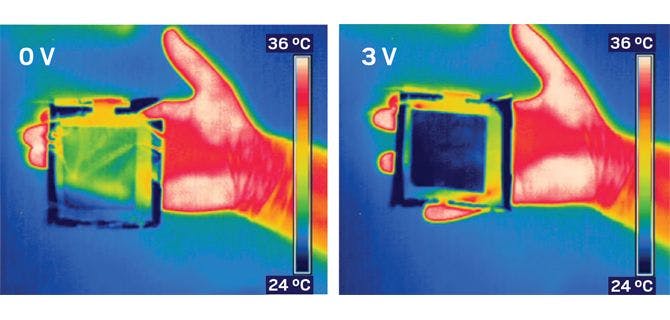Researchers have made a thermal camouflage device from graphene that can adjust how much heat it emits in response to the background temperature. The material could be used to hide people and planes from night-vision cameras, but also help satellites survive extreme temperatures in space or lead to more responsive home heating systems. Above absolute […]

Researchers have made a thermal camouflage device from graphene that can adjust how much heat it emits in response to the background temperature. The material could be used to hide people and planes from night-vision cameras, but also help satellites survive extreme temperatures in space or lead to more responsive home heating systems.
Above absolute zero, all materials radiate thermal energy, often in the form of infrared light. Night-vision goggles and other thermal cameras work by detecting this IR heat emission. Making a material whose IR emissivity can be tuned on the fly could be useful for thermal camouflage and other applications, but it is extremely challenging, says Coskun Kocabas, a materials scientist at the University of Manchester. Previous attempts have yielded rigid devices, ones that changed their thermal colors too slowly, or devices that could only work in a narrow band of IR wavelengths.
Kocabas’ research is focused on controlling the electrical and optical properties of graphene. Stacks of the stuff interact with IR light, a property that’s dependent on the surface charge of the graphene. So Kocabas decided to try controlling this charge accumulation—and thereby IR emission—with ionic liquids, which contain positively and negatively charged ions. He and his colleagues made thin, flexible devices consisting of a gold electrode, a layer of transparent polyethylene carrying a pool of ionic liquid, and a stack of graphene sheets. The ionic liquid, made of DEME and TFSI ions, supplies charges to the graphene. By controlling the accumulation of charge, the researchers can control how much IR light the graphene stacks emit.
When the researchers applied a voltage across the device, ions in the liquid moved in between the graphene stacks, a process called intercalation. The higher the voltage, the more ions intercalated into the carbon layers and the less IR light the graphene emitted. The team tested the device by draping it over a researcher’s hand. With the device off, the heat from the researcher’s palm could be seen through the device with an IR camera. But at an applied voltage of 3 V, the part of the hand covered by the device disappeared from the screen. The voltage caused the device to emit less IR radiation, rendering the researcher’s fingers thermally invisible.
Next, Kocabas wanted to make a device that could sense and respond to the environment, disappearing into a changing thermal background the way a swimming cuttlefish can rapidly change its coloration pattern to blend into the sand or corals beneath it. To do this, the group linked the thermal camouflage device to a temperature sensor and a control circuit to create a feedback loop based on the background temperature and the apparent temperature of the device itself. Then they tested the device by placing it on a hotplate. As the temperature changed, the thermal camouflage material adjusted the voltage across the device, changing its IR emissivity in less than a second so that its apparent temperature matched the background. This is the first time a surface can change its apparent temperature in response to the environment, Kocabas says.
John A. Rogers, a materials scientist at Northwestern University who develops flexible optoelectronic materials and devices, says this is “a very creative concept, demonstrated in a very convincing manner.”
Kocabas says the responsive materials could be used to make heaters that change how much energy they radiate in response to, say, a person walking into the room. They could also be temperature-regulating skins for satellites: “When a satellite faces the sun, it’s very hot, and when it faces deep space, it’s very cold,” he says. “We can make a dynamic radiator so that it can go into reflective and absorbing mode” depending on the temperature it detects. To make that happen, the researchers have to work on the reliability of the devices: The first prototypes can only switch about 500 times before they fail, probably because the gold electrodes need better protection from the corrosive ionic liquid.
This article is reproduced with permission from C&EN (© American Chemical Society). The article was first published on July 16, 2018.
